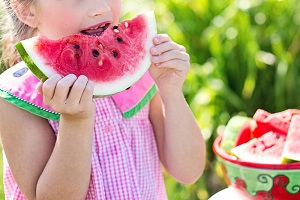Vegies are best for baby's first solids

From the Mothers and their Children’s Health substudy
Media Release: 3rd July 2020
If we want children to eat more fruit and vegetables, a vegetables first approach to weaning might be the key.
Professor Gita Mishra, Professor Annette Dobson, A/Professor Leigh Tooth and I found that children aged 2-12 years who were given fruit or vegetables instead of cereal as their first semi-solid food in infancy ate fruit and vegetables more frequently in childhood, and ate a wider variety of vegetables.
Breastfeeding also played a role, with children who received six months of breastmilk eating a wider variety of vegetables than those who had less than six months. Interestingly, supplementing with formula didn’t make a difference to fruit and vegetable intake compared with exclusive breastfeeding.
In Australia, only 5 per cent of children meet the guidelines for fruit and vegetable consumption, which puts them at risk of adult diseases like hypertension and stroke. This low vegetable intake has persisted for the last 20 years, which means we need some new solutions.
We wanted to see whether infant feeding practices might make a difference. Breastfeeding can provide a ‘flavour bridge’ because the taste varies with the mother’s diet (whereas formula is consistent in taste). Introducing solid foods teaches infants about tastes and textures, and helps them to accept the more bitter flavours in vegetables.
We asked mothers in the Australian Longitudinal Study on Women’s Health questions about how they fed their babies (breastfeeding, formula feeding and introducing solids). We also asked them about fruit and vegetable intake in childhood (frequency and variety of fruits and vegetables). We ran a series of multilevel regression models to explore the relationship between infant feeding and childhood fruit and vegetable intake, controlling for maternal fruit and vegetable intake and socioeconomic factors like maternal education.
We found that breastfeeding was associated with eating a wider variety of vegetables in childhood, which supports the ‘flavour bridge’ theory. However, first semi-solid food was a more consistent predictor of fruit and vegetable intake than breastfeeding. This has important implications because not all mothers are able to breastfeed to six months, but most parents are able to use vegetables as the first semi-solid food.
Infancy is a window of opportunity for establishing taste preferences that could make a life-long difference to diet and health. Most parents start complementary feeding with cereal (75 per cent in our study), but a vegetables first approach is ideal.
Parents can start introducing semi-solid foods when their baby shows they’re developmentally ready (e.g. they have good control of their head and neck, they show interest in solid foods). This usually happens between five to six months but could be earlier for some babies. Semi-solid foods shouldn’t be introduced before 4 months.
More information on infant feeding and introducing semi-solid foods can be found on the Australian Government’s Raising Children website.
The research on which this press release is based was conducted as part of the Australian Longitudinal Study on Women’s Health by the University of Queensland and the University of Newcastle. We are grateful to the Australian Government Department of Health for funding and to the women who provided the survey data.

